Hey, let’s talk about keeping your plants healthy and avoiding root rot. Overwatering is a sneaky culprit, so don’t just pour water without checking the soil first—stick your finger in about 2 inches deep to test moisture. If it’s still damp, hold off. This simple trick can save your plants from drowning, but there’s more to uncover about drainage and other tips to keep them thriving.
Contents
Overwatering Risks Root Rot
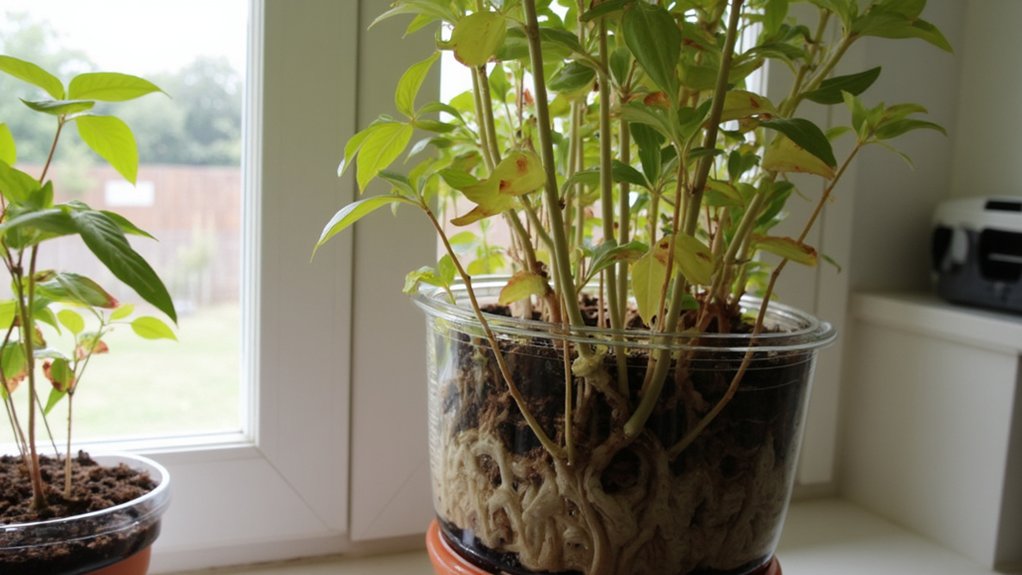
While it might seem like more water equals healthier plants, overwatering is actually a major culprit behind root rot. You’re drowning those roots, buddy, when you pour on too much! Excess water suffocates them, preventing oxygen from reaching the plant’s base, which triggers decay.
Check your watering habits to avoid this mess. Stick your finger about 1-2 inches into the soil; if it’s damp, hold off. Most houseplants only need water every 7-10 days, depending on their type. Always use a pot with holes at the bottom to let extra moisture escape.
Don’t guess—set a schedule. Mark your calendar for watering days, and adjust based on the season. Keep it simple, and you’ll save your plants from a soggy doom!
Poor Drainage Causes Rot

As you immerse yourself in caring for your plants, remember that poor drainage can quickly lead to root rot. When water can’t escape, it sits in the soil, suffocating roots. This creates a soggy mess, and trust me, your plants won’t thank you for it.
Check your pots for drainage holes—every container needs at least one, about ½ inch wide. If there’s none, grab a drill and make a few, pronto. Pair that with a saucer to catch excess water, emptying it within 30 minutes after watering.
Also, use well-draining soil, like a mix with perlite or sand, to prevent buildup. Test it by watering; if it pools on top for over a minute, mix in more drainage material.
Fungal Growth Promotes Rot
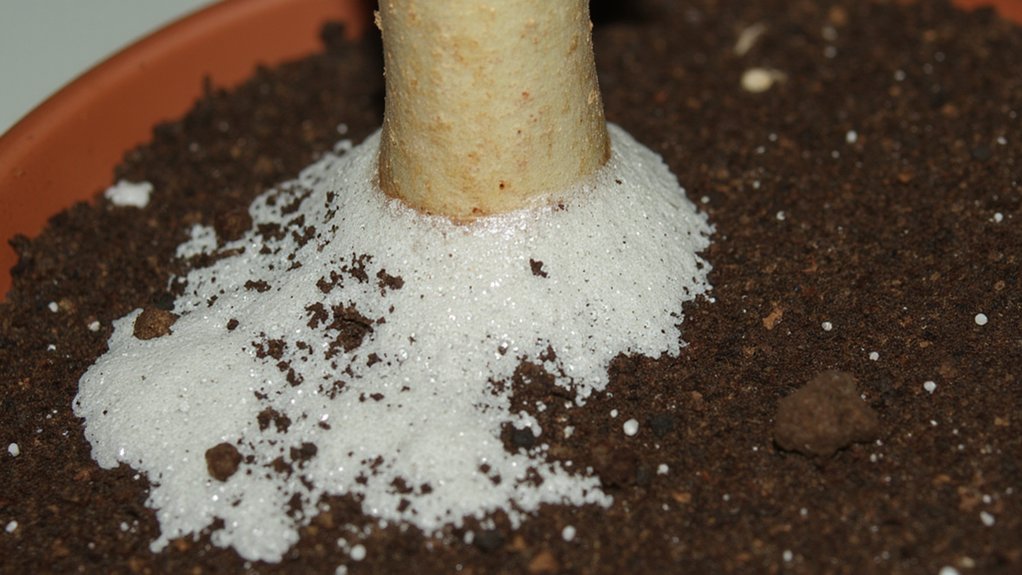
Since fungal growth thrives in damp conditions, you’ve got to stay vigilant to keep root rot at bay. Fungi love wet roots, and if you’re not careful, they’ll spread fast, damaging your plants.
Check your pots weekly for excess moisture. If you spot whitish or fuzzy growth on the soil surface, act immediately—scrape off the top layer, about 1-2 inches, with a spoon. Then, let the plant dry out for 3-5 days before watering again.
Don’t overwater, as soggy conditions are a fungal playground. Stick your finger 1 inch into the soil; if it’s damp, hold off. Also, guarantee good air circulation around plants by spacing them 6-12 inches apart. Fungi hate moving air, so you’re one step ahead!
Soil Choice Prevents Rot
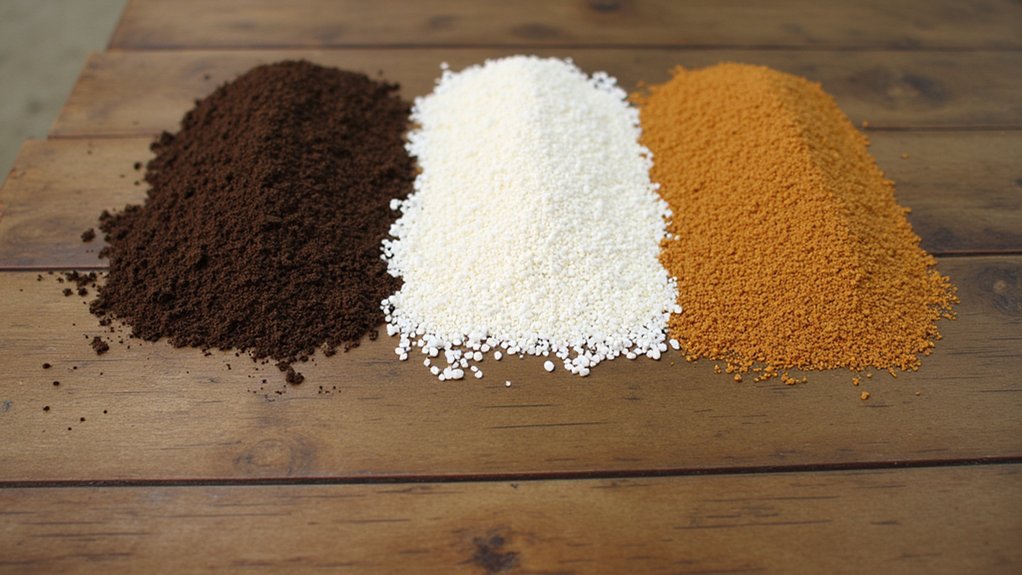
Hey, picking the right soil is your secret weapon against root rot. You’ve gotta choose a mix that drains well, so water doesn’t sit around, drowning your plant’s roots. Look for soil labeled as “well-draining” or blend your own with specific ratios.
Start with 50% potting soil, then add 30% perlite for aeration, and 20% coarse sand for drainage. Mix it thoroughly in a large bucket, breaking up clumps with your hands. This combo lets excess water escape fast, usually within 10-15 seconds after watering, keeping roots safe.
Don’t grab heavy, clay-like soil; it traps moisture and invites rot. Test your mix by watering a small batch—if it holds puddles, adjust by adding more perlite. Keep experimenting till it’s right!
Proper Pot Selection
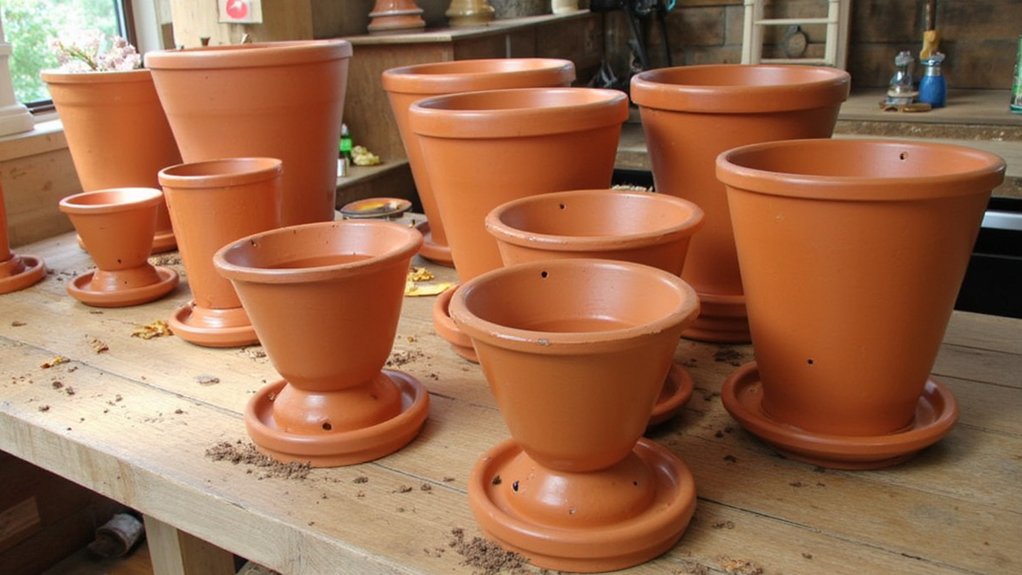
Picking the perfect pot is just as essential as soil for stopping root rot. You’ve gotta choose one with drainage holes, ideally 0.5 to 1 inch wide, at the bottom. Without them, excess moisture can’t escape, and that’s a fast track to soggy roots.
Look for pots made of breathable materials, like terracotta or unglazed ceramic, which help wick away extra dampness. Plastic pots work too, but only if they’ve got those vital holes. Check the size—your pot should be 1-2 inches wider than the plant’s root ball, giving it room without drowning in soil.
Finally, grab a saucer or tray underneath. It’ll catch drips, keeping your space tidy, while you focus on healthy growth.
Monitor Watering Frequency
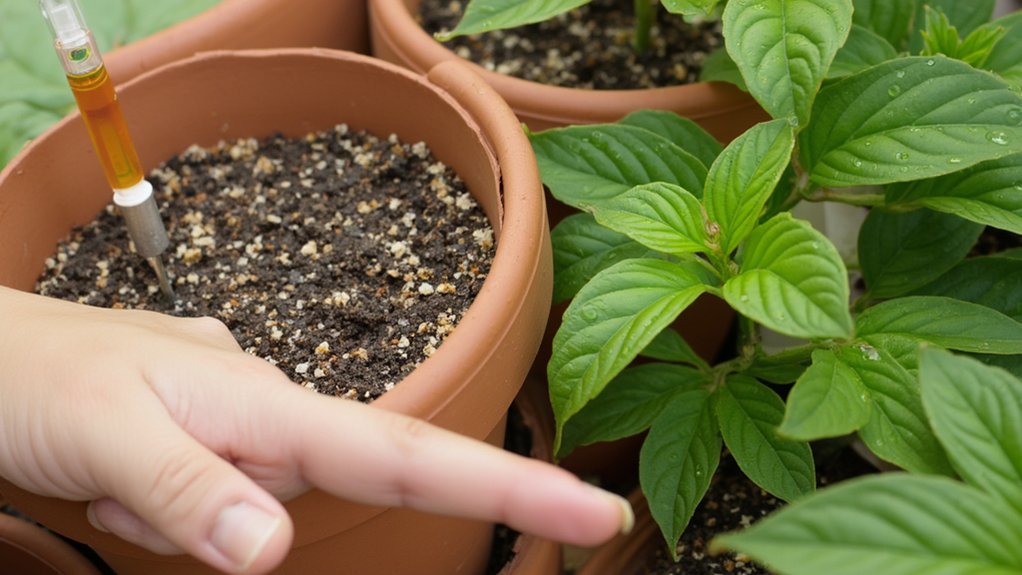
Let’s shift gears and talk about monitoring your watering frequency, a key step after getting the right pot setup. Overwatering’s a sneaky culprit behind root rot, so you’ve gotta be vigilant. Stick to a schedule, but don’t just pour on autopilot.
Check the soil first—poke your finger about 1-2 inches deep. If it feels damp, hold off; if it’s dry, water slowly until it seeps out the drainage holes, roughly 10-20% of the pot’s volume. Different plants need different rhythms, like succulents every 2 weeks, while ferns might crave moisture every 5-7 days. Adjust based on your home’s humidity and light, too. Keep a log if you’re forgetful, noting dates and amounts. Stay sharp, and you’ll dodge soggy disasters.
Inspect Roots Regularly
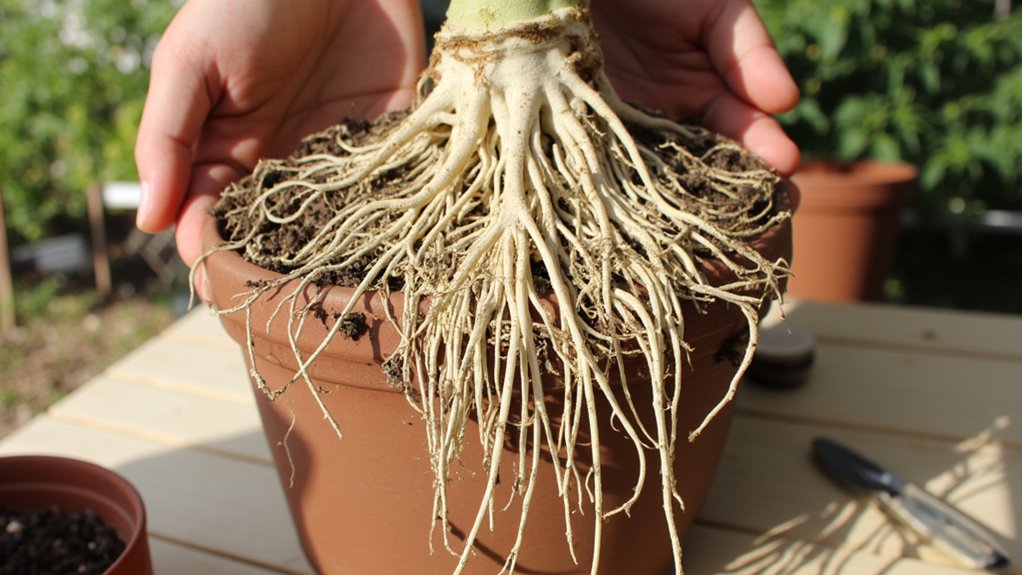
Three times a year, make it a habit to inspect your plant’s roots for early signs of rot. Schedule these checks in spring, summer, and fall to catch issues early. It’s a simple task, but it can save your plants.
Gently lift your plant from its pot, shaking off excess soil to expose the roots. Look for dark, mushy spots or a foul smell—these are red flags. Healthy roots should be firm, white or light tan, and spread evenly.
If you spot trouble, trim away the damaged parts and repot in fresh, well-draining soil. Don’t wait for wilting leaves to alert you; by then, it’s often too late. Stay proactive, and you’ll keep root rot at bay.
Use Sterilized Tools
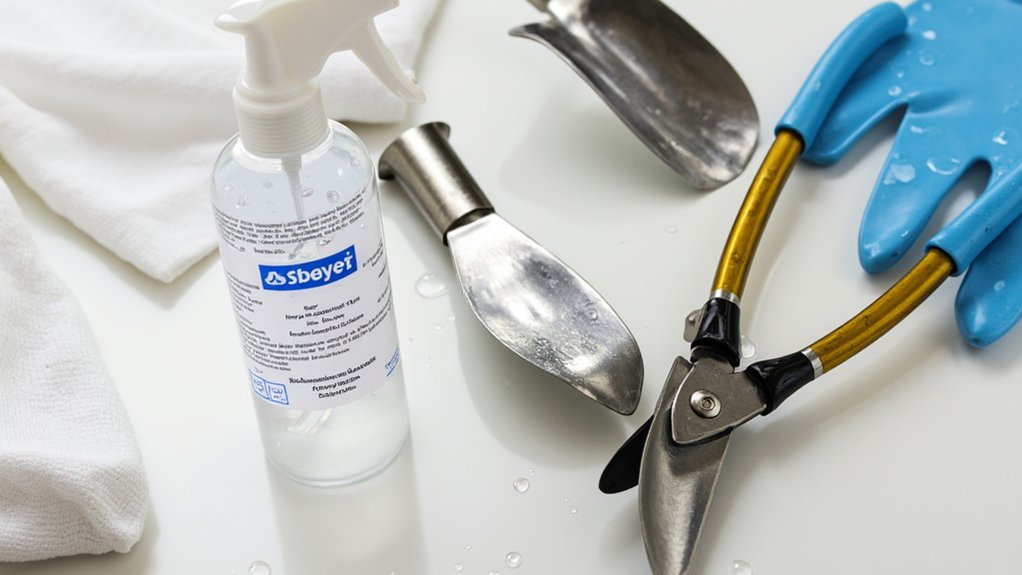
While you’re tending to your plants, don’t overlook the importance of using sterilized tools. Dirty tools can spread harmful fungi or bacteria, risking root rot. So, grab that pruning shear or trowel, and let’s clean it up!
Before each use, wipe your tools with rubbing alcohol, using a cloth soaked in a 70% solution. Let them air dry for about 5 minutes to guarantee no residue lingers. If you’ve got multiple plants, sterilize between each one; it’s a quick 30-second task that saves headaches.
Got a stubborn grime buildup? Soak the tool in a bleach-water mix, 1 part bleach to 9 parts water, for 10 minutes. Rinse thoroughly, dry it off, and you’re good to go. Keep those roots safe!
Promote Air Circulation

After ensuring your tools are clean, turn your attention to promoting air circulation around your plants. Good airflow helps prevent root rot by reducing excess moisture, so don’t skip this step.
Start by spacing your pots at least 12 inches apart, if possible, to avoid crowding. This gives each plant room to breathe, preventing damp, stagnant conditions near the soil.
Next, consider using a small fan in indoor setups, running it for 4-6 hours daily on a low setting. Position it 2-3 feet away, ensuring gentle movement, not a harsh blast, to keep air flowing.
Lastly, trim dense foliage every 2-3 weeks, cutting away overlapping leaves. This simple act boosts ventilation right where it’s needed most, down at the base.
Apply Fungicide Preventively
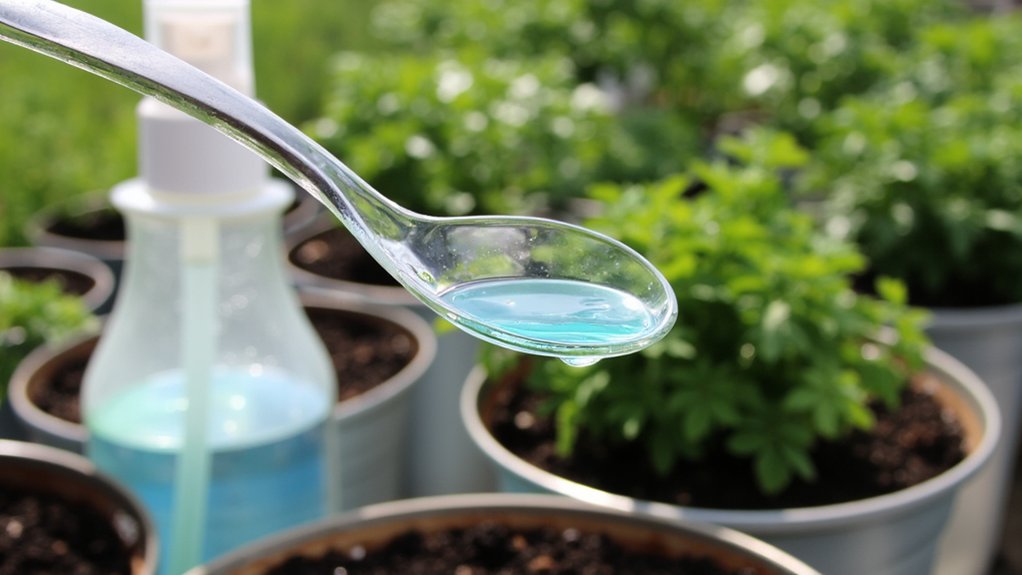
Before root rot even gets a chance to start, let’s talk about using fungicide as a preventive measure. You’ve gotta act before trouble brews, so grab a quality fungicide labeled for root rot prevention. Check the bottle for active ingredients like thiophanate-methyl or propiconazole, which target harmful fungi.
Start by mixing the fungicide according to the label—usually 1-2 teaspoons per gallon of water. Apply it directly to the soil around your plant’s base, ensuring you cover the root zone. Do this every 2-4 weeks during the growing season, especially if your area’s damp.
Don’t overdo it, though; follow the dosage strictly to avoid harming your plants. Keep a schedule, and you’ll stay ahead of root rot issues.
